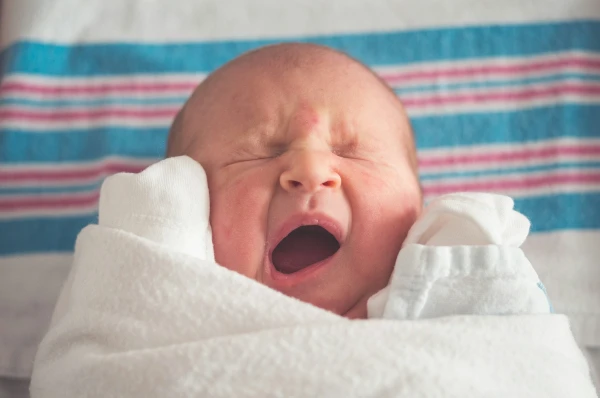What Is the 9-Month Sleep Regression?
The 9-month sleep regression is a temporary phase of disrupted sleep that typically occurs between 8 and 10 months. Your baby may:
- Wake up more often at night
- Resist naps (or take shorter naps)
- Have difficulty falling asleep
- Experience separation anxiety
- Wake up standing in the crib and not know how to get back down
This sleep regression is linked to major developmental changes—your baby is learning new skills, forming strong attachments, and becoming more aware of their world.
Good to Know: Not every baby experiences a noticeable sleep regression at this age. Some babies may skip it entirely, while others go through mild sleep disruptions rather than a full regression.
[sc name=”wheretostartguide”][/sc]
How Long Does the 9-Month Sleep Regression Last?
This phase typically lasts between 2 and 6 weeks.
However, how long it lasts depends on several factors:
- Your baby’s temperament – Some babies adjust quickly, while others take longer.
- Consistency of sleep routines – Babies with predictable sleep habits tend to return to normal more quickly.
- Other factors – Teething, illness, or travel can extend this phase.
Kim’s Tip: If sleep disruptions continue beyond 6 weeks, take a step back and evaluate your routine. Are wake windows appropriate? Is your baby getting enough daytime sleep? Small adjustments can make a big difference.

Signs of the 9-Month Sleep Regression
Wondering if your baby is going through a sleep regression? Here are the most common signs:
- Frequent night wakings (every 2-3 hours)
- Fighting naps or shorter naps
- Increased fussiness, especially at bedtime
- Practicing new skills at night (pulling up, crawling)
- Separation anxiety (crying when you leave the room)
- Early morning wakings (before 6 AM)
- Changes in appetite (hungrier or more distracted during feeds)
Kim’s Tip: If your baby’s sleep wasn’t great before, this phase may feel more intense. Stay consistent with routines and gentle sleep coaching strategies to help your baby adjust.
Is It the 9-Month Sleep Regression or Something Else?
Not every sleep disruption is a regression. Sometimes, other factors are at play:
Teething vs. Sleep Regression
- Teething: Baby is fussy day and night, may have swollen gums, drooling, and biting.
- Regression: Baby is happy during the day but struggles with sleep-related issues.
Solution: If teething is a factor, offer a cool teething ring or gentle gum massage before bed.
Growth Spurt vs. Sleep Regression
- Growth spurt: Increased hunger, frequent feeding, but sleep settles within a few days.
- Regression: Sleep remains disrupted for weeks.
Solution: If your baby is waking hungry, try adding an extra solid meal during the day.
Illness vs. Sleep Regression
- Illness: Fever, congestion, cough, daytime fussiness.
- Regression: No signs of illness, just sleep struggles.
Solution: If your baby is sick, focus on comfort and resume sleep coaching when they’re feeling better.
[sc name=”sleep-help”][/sc]
It might be hard to imagine it when your baby’s sleep challenges are difficult, but this sleep regression will pass just like the others before it. And if you find yourself with new unwanted habits or sleep challenges that don’t resolve on their own, check back in to this blog or consider speaking with a Gentle Sleep Coach.
How to Handle Naps During the 9-Month Sleep Regression
Naps can become unpredictable during this phase, but sticking to a 9 month sleep schedule will help:
- Keep 2 naps per day (morning & afternoon)
- Aim for 1.5 hours per nap (but expect some short naps)
- Try to avoid late afternoon naps (which can interfere with bedtime)
Kim’s Tip: If your baby resists naps, offer quiet time instead. Even if they don’t sleep, resting in a calm environment helps reset their system.
Final Thoughts
The 9-month sleep regression is temporary, even though it can feel endless in the moment.
Focus on:
✔ Keeping a consistent routine
✔ Offering comfort without creating new sleep habits
✔ Helping your baby practice new skills during the day
Your baby will return to better sleep soon—and so will you!
Citations
- Cleveland Clinic. “Infant Sleep Regression: What Parents Need To Know” https://health.clevelandclinic.org/the-4-month-sleep-regression-what-parents-need-to-know
- S. Paruthi, L. Brooks, C. D’Ambrosio, W. Hall, S. Kotagal, Robin M. Lloyd, B. Malow, K. Maski, C. Nichols, S. Quan, C. Rosen, M. Troester and M. Wise. “Recommended Amount of Sleep for Pediatric Populations: A Consensus Statement of the American Academy of Sleep Medicine..” Journal of clinical sleep medicine : JCSM : official publication of the American Academy of Sleep Medicine, 12 6 (2016): 785-6 . https://doi.org/10.5664/jcsm.5866.
- Suni, Eric, and Dr. Nilong Vyas. “Sleep Training.” Sleep Foundation, December 17, 2020. https://www.sleepfoundation.org/baby-sleep/sleep-training.
- American Academy of Pediatrics, “Cognitive Development: 8 to 12 Months,” HealthyChildren.org, November 20, 2023, https://www.healthychildren.org/English/ages-stages/baby/Pages/Cognitive-Development-8-to-12-Months.aspx.
- American Academy of Pediatrics, “Movement: 8 to 12 Months,” HealthyChildren.org, April 7, 2021, https://www.healthychildren.org/English/ages-stages/baby/Pages/Movement-8-to-12-Months.aspx.
- Hernandez-Reif, Maria and Nahide Gungordu. “Infant sleep behaviors relate to their later cognitive and language abilities and morning cortisol stress hormone levels.” Infant behavior & development 67 (2022): 101700. https://www.sciencedirect.com/science/article/abs/pii/S0163638322000145?via%3Dihub
- Quante, Mirja et al. “Associations of sleep-related behaviors and the sleep environment at infant age one month with sleep patterns in infants five months later.” Sleep medicine vol. 94 (2022): 31-37. doi:10.1016/j.sleep.2022.03.019
- E. J. Paavonen, O. Saarenpää-Heikkilä, I. Morales-Muñoz, Minna Virta, Niina Häkälä, P. Pölkki, A. Kylliäinen, H. Karlsson, T. Paunio, L. Karlsson and J. Paavonen. “Normal sleep development in infants: findings from two large birth cohorts..” Sleep medicine, 69 (2020): 145-154 . https://doi.org/10.1016/j.sleep.2020.01.009.
- MedlinePlus. “Bedtime Habits for Infants and Children.” MedlinePlus Medical Encyclopedia, October 21, 2022. https://medlineplus.gov/ency/article/002392.htm




